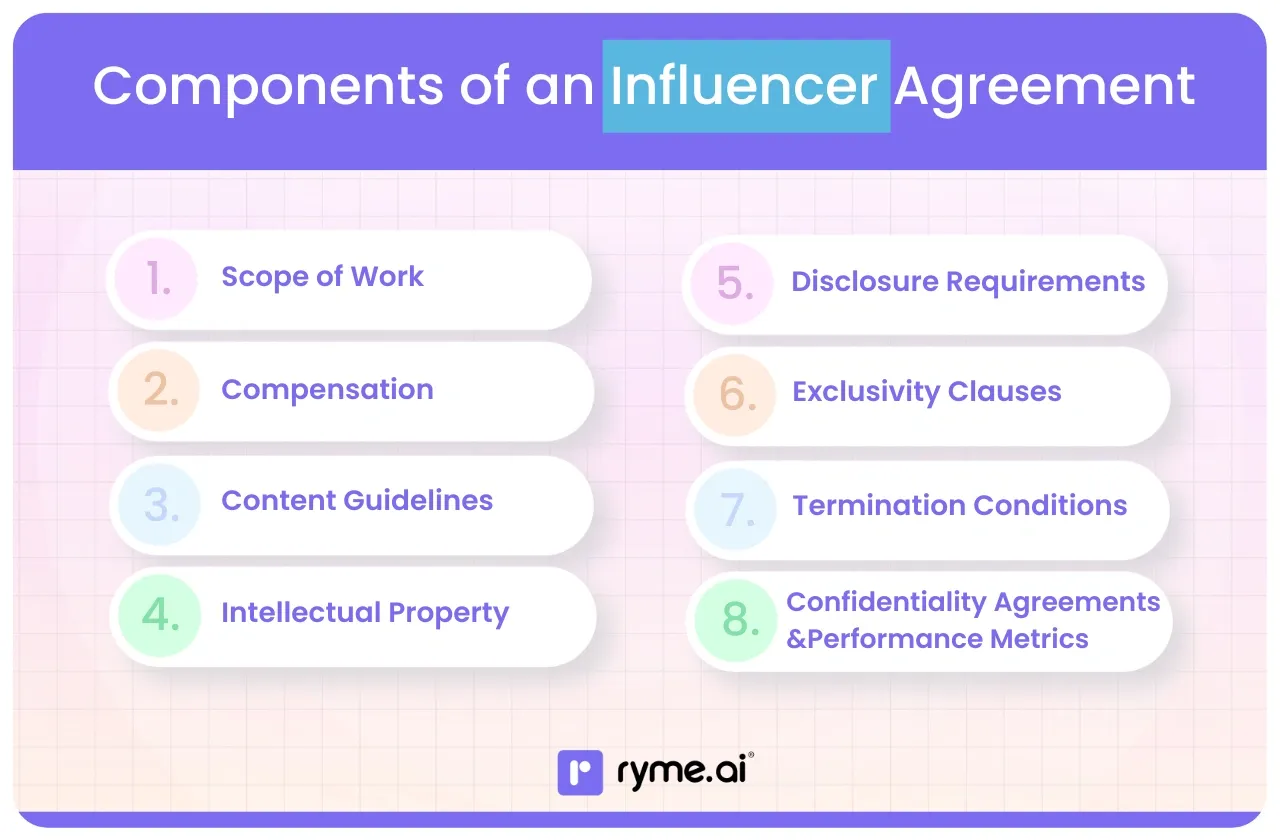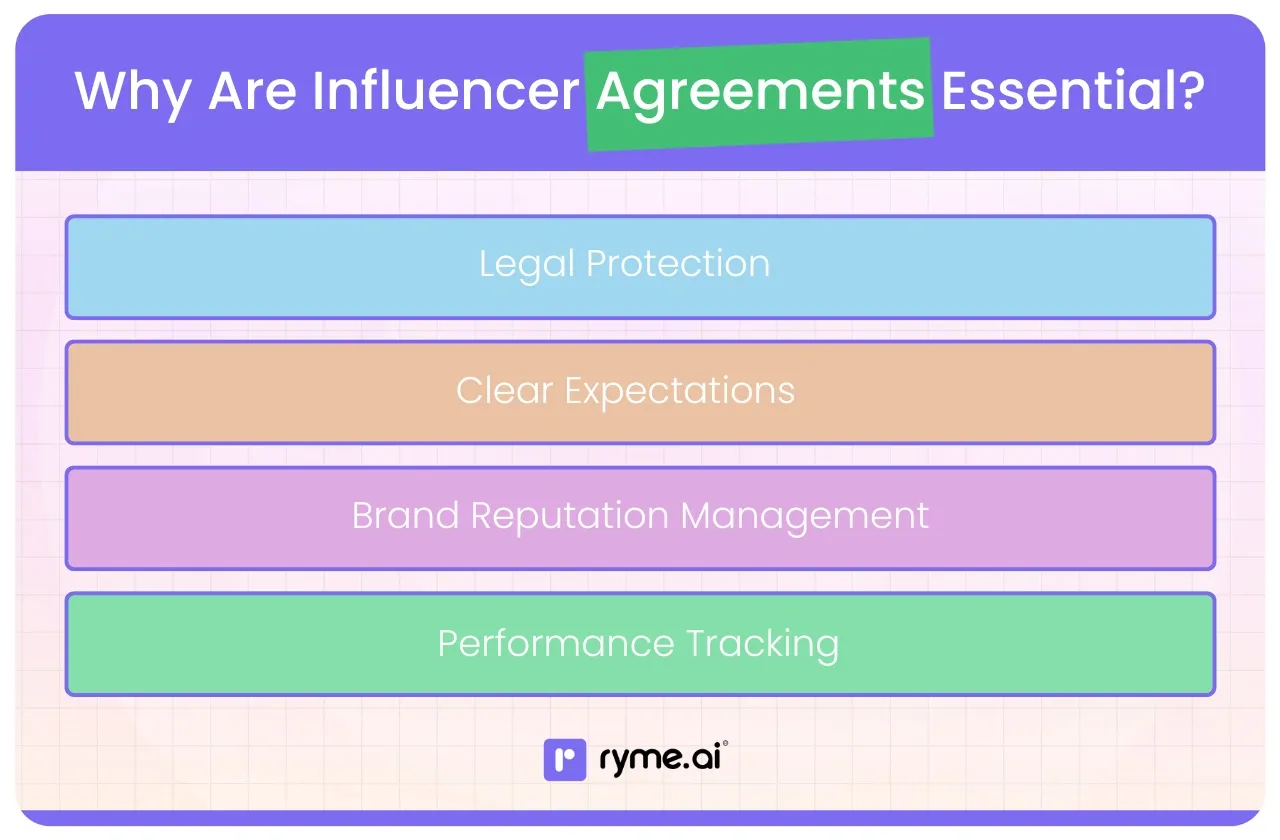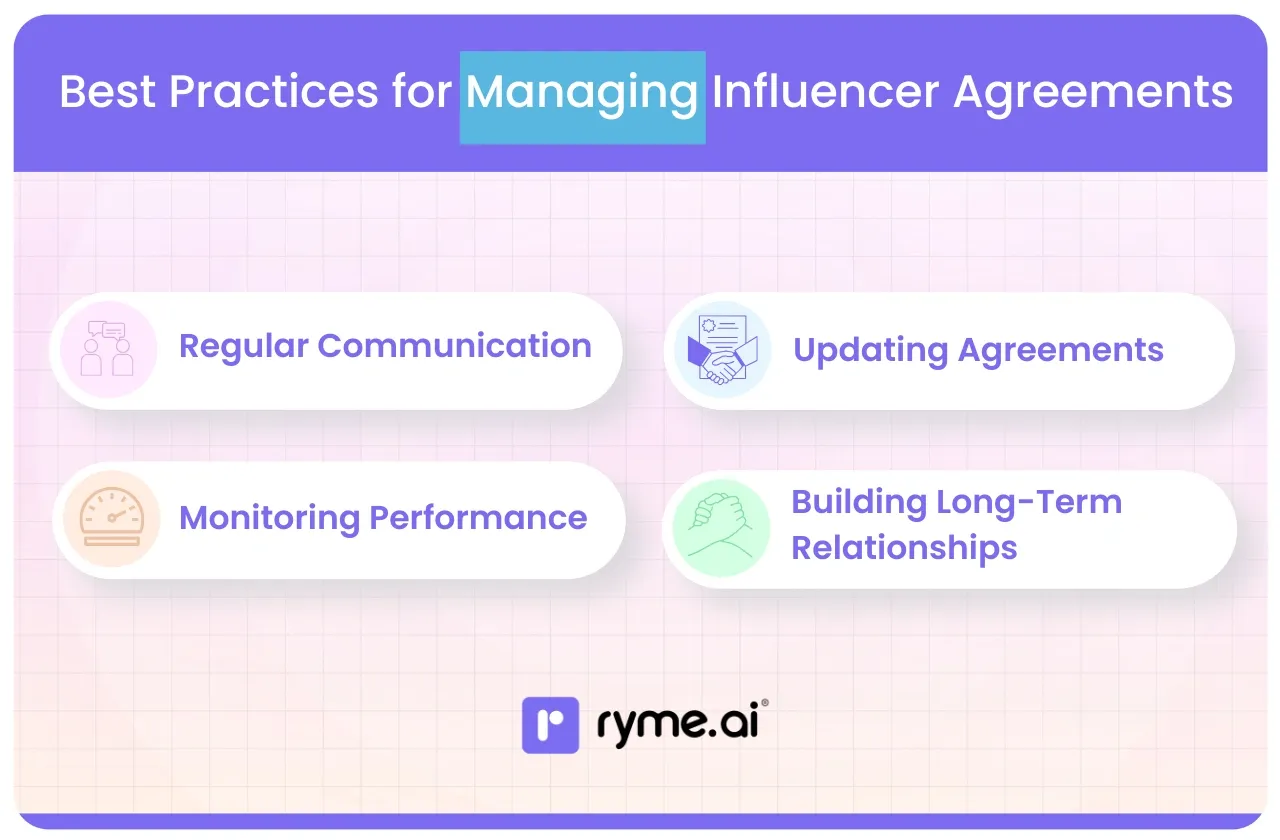Influencer Agreements: What, Why & How (2025)
Discover everything you need to know about influencer agreements! Learn what they are, why they matter, and how to create one that works for you.

Partnering with influencers can be incredibly powerful for your brand, but like any good partnership, it needs a solid foundation. That's where influencer agreements come in – they're your roadmap to a smooth, successful, and legally sound collaboration. Think of this guide as your friendly mentor, here to walk you through everything you need to know. Let’s get started! ✨
What Is an Influencer Agreement?
At its core, an influencer agreement (also sometimes called an influencer contract or collaboration agreement) is a legally binding document. It clearly outlines all the terms and conditions of a working relationship between your brand (that's you!) and an influencer.
Imagine you're planning a big project with someone. You wouldn't just rely on vague conversations, right? You'd want things written down. An influencer agreement does exactly that for your marketing campaigns. It takes all those exciting collaboration ideas discussed over emails or calls and formalizes them.
Why is this formalization so important?
- Sets Clear Expectations: It spells out precisely who is responsible for what. What content needs creating? When is it due? What should it look like? What platforms should it be on? This eliminates guesswork and prevents confusion down the line.
- Defines Responsibilities: It clarifies the duties of both your brand and the influencer. This includes everything from content creation and posting schedules to approvals and payment terms.
- Outlines Deliverables: It specifies the exact pieces of content or actions the influencer needs to complete as part of the campaign. No more "I thought you meant..." moments!
- Provides Legal Protection: This is a big one! It protects both you and the influencer if disagreements arise or if something doesn't go according to plan. It ensures everyone is aware of their rights and obligations.
Think of it as the rulebook for your collaboration game. When everyone knows the rules and agrees to them upfront, the game is much more likely to be fun and successful for everyone involved. Without it, you're essentially navigating a complex partnership based on assumptions, which can unfortunately lead to misunderstandings, disappointment, or even legal trouble.
Common Components of an Influencer Agreement
Alright, let's break down what typically goes into one of these agreements. While every agreement can be tailored, most effective ones include these key sections:

Scope of Work (The "What" and "When"): This is arguably the most detailed section. It needs to be crystal clear about what the influencer is expected to do.
Content Details: What type of content? (e.g., Instagram Reel, YouTube video, blog post, static image, Story sequence). How many pieces of content? What's the theme or topic? Should specific product features be highlighted?
- Platform Specifics: Which social media platforms should the content be posted on? (e.g., Instagram, YouTube, TikTok, LinkedIn, Twitter, Blog).
- Posting Schedule: Exact dates or date ranges for when each piece of content should go live. Include times if specific timing is important for your campaign (e.g., during peak engagement hours).
- Duration: How long should the content remain live? Does it need to stay pinned for a certain period?
- Example: “Influencer agrees to create and post: Two (2) Instagram Reels (60-90 seconds each) featuring the [Product Name], demonstrating its ease of use. One Reel to be posted by 5 PM IST on July 15th, 2025, and the second by 5 PM IST on July 22nd, 2025. Influencer will also post three (3) Instagram Stories linking to the brand’s website on the day each Reel goes live.”
Compensation (The "How Much" and "How"): Money matters! This section details how the influencer will be paid for their work.
- Payment Amount: The specific fee agreed upon. State this clearly in Indian Rupees (₹). Will it be a flat fee per campaign, per post, or based on performance?
- Payment Terms: When will the payment be made? (e.g., 50% upfront upon signing, 50% upon completion; net 30 days after final post goes live). How will payment be made? (e.g., bank transfer, UPI).
- Performance-Based Incentives (Optional): If applicable, outline any bonuses tied to specific results like clicks, conversions, or engagement rates. Define how these will be tracked and paid.
- Product Gifting: If compensation includes free products (product seeding), clearly state the value and whether it's part of the payment or in addition to a monetary fee.
- Example: “Brand agrees to pay Influencer a total fee of ₹25,000. Payment will be made as follows: ₹12,500 upon signing this agreement and submission of draft content for approval, and ₹12,500 within 15 business days of the final deliverable being posted live and verification of all requirements met. Payment via bank transfer.”
Content Guidelines (The "Do's and Don'ts"): This ensures the influencer's content aligns with your brand's image and messaging.
- Brand Voice & Tone: Describe the desired style (e.g., fun and quirky, professional and informative, aspirational).
- Key Messages: Specify any essential points or taglines that must be included.
- Visual Guidelines: Any requirements for logos, colours, or overall aesthetic?
- Restrictions (The Don'ts): List anything the influencer should avoid mentioning or showing (e.g., competitor products, controversial topics, specific language).
- Approval Process: Detail how and when the influencer needs to submit content for your review before posting. How long will you take to approve or provide feedback?
- Example: “Content should maintain a positive and authentic tone. Influencer must include the campaign hashtag #YourBrandMoment and tag @YourBrandHandle. Content must not feature competitor products or use profanity. Drafts must be submitted for review 72 hours before the scheduled posting date via email.”
Intellectual Property (IP) Rights (The "Who Owns What"): This is crucial! It determines who owns the content created and how it can be used.
- Ownership: Typically, the influencer owns the copyright to the content they create. However, brands often license the rights to use it.
- Usage Rights (License): Clearly define how your brand can use the influencer's content. Can you repost it on your own social media? Use it in paid ads? On your website? For how long? In which geographical regions? Be specific! The broader the rights you need, the more you might need to compensate the influencer.
- Example: “Influencer grants Brand a non-exclusive, worldwide, royalty-free license to repurpose, share, and use the content created under this agreement on Brand’s owned digital channels (including website, social media profiles, email marketing) for a period of twelve (12) months from the date of the final post.”
Disclosure Requirements (Staying Legal and Transparent): This ensures compliance with advertising standards. In India, the Advertising Standards Council of India (ASCI) has specific guidelines.
- Mandatory Disclosures: Require the influencer to clearly disclose that their content is promotional. This usually involves using hashtags like #ad, #sponsored, #collaboration, or platform-specific built-in tools (like Instagram's "Paid Partnership" tag). Specify which disclosures are required and where they should appear (e.g., prominently at the beginning of captions or video content).
- Compliance: State that the influencer must adhere to all relevant laws and platform policies regarding advertising disclosures.
- Example: “Influencer must clearly and conspicuously disclose the material connection with the Brand in all campaign content. This includes using the #ad hashtag within the first three lines of the Instagram caption and utilizing Instagram’s ‘Paid Partnership with [Your Brand Name]’ tool for all posts and Reels.”
Exclusivity Clauses (Working Only With You?): This prevents an influencer from promoting direct competitors during your campaign period.
- Scope of Exclusivity: Define which types of brands or products are considered competitors. Be specific (e.g., "other skincare brands," "competing fast-food chains").
- Duration: Specify the timeframe for the exclusivity (e.g., "during the campaign period," "for 30 days after the final post"). Be reasonable; overly long or broad exclusivity clauses might deter influencers or require higher compensation.
- Example: “During the term of this agreement and for fourteen (14) days following the final post, Influencer agrees not to enter into any promotional agreement or publish content promoting any other direct-to-consumer coffee brands.”
Termination Conditions (The "What If It Doesn't Work Out?"): Outlines how and why the partnership can be ended prematurely.
- Grounds for Termination: List valid reasons for either party to end the agreement (e.g., breach of contract, failure to deliver content, misrepresentation, posting inappropriate content, bankruptcy).
- Notice Period: Specify how much advance notice is required if one party decides to terminate (unless it's for a serious breach).
- Consequences: What happens upon termination? (e.g., final payments owed for work completed, return of products, cessation of content usage rights).
- Example: “Either party may terminate this agreement with 7 days written notice if the other party breaches a material term of this agreement and fails to rectify the breach within that notice period. Brand may terminate immediately if Influencer posts content that harms Brand’s reputation.”
Confidentiality Agreements (Keeping Secrets Safe): Protects sensitive information shared during the collaboration.
- Definition of Confidential Information: Specify what constitutes confidential information (e.g., upcoming product details, campaign strategies, sales data, proprietary information).
- Obligations: State that the influencer must not disclose this information to third parties without your written consent, both during and after the campaign.
- Example: “Influencer agrees to keep all non-public information provided by the Brand, including campaign plans and business strategies, strictly confidential and shall not disclose it to any third party.”
Performance Metrics (Measuring Success): Defines how you'll track the campaign's effectiveness.
- Key Performance Indicators (KPIs): List the metrics you'll be monitoring (e.g., reach, impressions, engagement rate, clicks, conversions, website traffic, uses of a specific discount code).
- Tracking Methods: How will these KPIs be tracked? (e.g., UTM parameters in links, influencer-specific discount codes, platform analytics provided by the influencer).
- Reporting: Specify if/when the influencer needs to provide performance reports (e.g., screenshots of analytics 7 days after posting).
- Example: “Influencer agrees to provide screenshots of Instagram Insights (Reach, Impressions, Engagement Rate, Link Clicks) for all campaign posts and Reels within 7 days of posting. Success will be evaluated based on overall engagement and traffic driven to the Brand’s website via the provided UTM link.”
Phew! That might seem like a lot, but each piece plays a vital role in creating a clear, fair, and effective partnership.
Why Are Influencer Agreements Essential?
Okay, you know what goes into an agreement, but why is it so non-negotiable? Especially for growing D2C brands where time and resources might feel tight, is this paperwork really worth it? Absolutely, YES! 🙌 Here’s why:

1) Legal Protection (Your Safety Net):
Dispute Prevention: Let's be real, sometimes things go wrong. An influencer might misunderstand the brief, miss a deadline, or post something off-brand. A brand might delay payment or change campaign scope last minute. An agreement provides a clear reference point agreed upon by both parties. If a dispute arises, you can refer back to the contract terms to resolve it. This can save you time, money, and major headaches compared to arguing over undocumented expectations.
Compliance Assurance: The digital advertising space is constantly evolving, and regulators (like ASCI in India) are cracking down on non-compliance, especially regarding disclosures. An agreement ensures you formally require influencers to follow these rules (like using #ad), protecting your brand from penalties and negative publicity associated with deceptive advertising.
Platform policies (like Instagram's branded content rules) also need adherence, and the agreement reinforces this. According to recent reports and regulatory actions since 2022, transparency in influencer marketing isn't just good practice; it's increasingly mandated.
2) Clear Expectations (No More Guesswork):
Defined Roles & Deliverables: The agreement leaves no room for ambiguity. Everyone knows exactly what content is expected, when it's due, on which platforms, and what key messages to include. This prevents scope creep (where the project grows beyond the original agreement) and ensures the influencer delivers what you actually need for your campaign.
Timelines: Agreed-upon deadlines keep the campaign on track. If you have a product launch or a specific sales period, timely influencer posts are crucial. The agreement formalizes these timelines.
Example: Verbally briefing an influencer for a "fun Reel" can lead to misunderstandings. Their idea of fun might mean costly, complex transitions or a focus on unintended product features. A detailed scope of work in the agreement prevents this. For instance, it might stipulate: "Reel to showcase X and Y features with a maximum of 5 on-screen text overlays."
3) Brand Reputation Management (Protecting Your Image):
Maintaining Brand Voice: Your brand has a unique personality and values. The content guidelines section ensures the influencer's content aligns with this image. It helps maintain consistency across all your marketing efforts.
Grounds for Action: What if an influencer posts something offensive, inaccurate, or completely off-brand, even after agreeing to guidelines? The termination clause in your agreement gives you grounds to end the partnership swiftly and potentially request content removal, protecting your brand from negative association. Without an agreement, managing such situations becomes much harder.
4) Performance Tracking (Knowing What Works):
Measurable Goals: By defining Key Performance Indicators (KPIs) and reporting requirements in the agreement, you set clear expectations for how success will be measured. This isn't about micromanaging; it's about understanding the return on your investment (ROI).
Data-Driven Decisions: The data collected (as stipulated in the agreement) helps you assess the effectiveness of the collaboration. Did this influencer drive engagement? Sales? Website traffic? This information is vital for optimizing future campaigns and deciding which partnerships are most valuable for your brand. You can learn what resonates with your audience and refine your strategy accordingly. Recent industry trends emphasize the growing importance of demonstrating tangible ROI from influencer marketing spend.
In short, an influencer agreement isn't just bureaucratic red tape. It’s a professional tool that fosters trust, clarity, and accountability. It transforms a potentially chaotic collaboration into a structured, predictable, and legally sound business arrangement, allowing you to confidently invest in influencer marketing and protect your brand's interests. Think of it as the insurance policy for your influencer marketing budget and brand reputation.
How to Draft an Effective Influencer Agreement
Okay, you're convinced! You need an agreement. But where do you start? Drafting one might seem intimidating, but let's break it down into manageable steps. You've got this! 💪
Preparation Steps (Laying the Groundwork)
Before you even think about clauses, do your homework:
Identify Campaign Objectives and Desired Outcomes: What do you really want to achieve with this influencer collaboration?
- Be Specific: Don't just say "increase brand awareness." Aim for something measurable like "Increase Instagram profile visits by 15%," "Generate 50 leads through the influencer's link," "Drive ₹50,000 in sales using the influencer's unique discount code," or "Boost engagement rate on campaign posts by 5%."
- Align Objectives with Agreement: Knowing your goals helps you define the Scope of Work, KPIs, and even the type of influencer you need. If your goal is direct sales, you'll need trackable links and potentially performance-based compensation. If it's awareness, reach and impressions might be your key metrics.
- Select Influencers Whose Audience Aligns with Your Brand: This is crucial for campaign success.
Don't just chase follower counts!
- Audience Demographics: Does the influencer's audience match your target customer profile (age, location, interests, income level)? Most influencers can provide audience data.
- Brand Values Alignment: Does the influencer's content style, values, and overall image resonate with your brand? Authenticity is key. A mismatch can feel jarring to both their audience and yours. For example, a sustainable fashion brand partnering with an influencer known for fast fashion hauls might not be the best fit.
- Engagement Rate: Look beyond followers. How engaged is their audience? High engagement (likes, comments, shares relative to follower count) often indicates a more loyal and responsive community. A smaller, highly engaged audience can be more valuable than a massive, passive one.
- Content Quality: Does their existing content meet your quality standards? Is it creative, well-produced, and authentic?
Key Clauses to Include (The Nitty-Gritty)
Once you've prepped, focus on getting these core clauses right in the agreement draft:
Content Creation (Be Explicit!):
- Specificity is Your Friend: Don't just say "1 Instagram post." Specify: "One (1) static carousel post on Instagram, featuring 3-5 high-resolution images showcasing the product in use. The first image must clearly show the product packaging." The more detail, the less room for error.
- Include Mandatories: Clearly list any mandatory inclusions: specific hashtags, handles to tag (@YourBrand), key messages, call-to-actions (CTAs like "Link in bio!"), or specific product features to highlight.
- Example: “Deliverable 1: One Instagram Reel (60s max) demonstrating the unboxing and first impressions of [Product]. Must include verbal mention of key feature X and use hashtag #YourBrandLaunch. Due: July 10th.”
Approval Processes (Avoid Surprises):
- Outline the Steps: How will you review content before it goes live? Will drafts be sent via email, Google Drive, or a platform? Who from your team is responsible for approvals?
- Set Timelines: Specify how far in advance drafts are due (e.g., 5 business days before posting date). Crucially, also state your turnaround time for feedback or approval (e.g., "Brand will provide feedback or approval within 48 business hours of draft submission"). This keeps the process moving.
- Number of Revisions: Consider specifying the number of reasonable revision rounds included in the fee to manage expectations.
- Example: “Influencer will submit all draft content, including captions and visuals, via shared Google Drive folder link at least 5 business days prior to the scheduled posting date. Brand will provide consolidated feedback or approval within 2 business days. One round of reasonable revisions is included.”
Payment Terms (Clear and Fair):
- Structure: Flat fee? Per post? Product seeding only (common for micro-influencers, but be clear it's compensation)? Combination?
- Milestones: Link payments to specific actions (e.g., signing the contract, draft approval, final post live, report submission). This motivates timely delivery.
- Payment Schedule: Specify exact dates or windows (e.g., "within 15 days of campaign completion"). Remember to state the currency (₹).
- Invoicing: Detail any invoicing requirements (e.g., influencer needs to submit an invoice with GST details if applicable).
- Example: “Total Fee: ₹15,000. Payment Schedule: 50% (₹7,500) upon signing and 50% (₹7,500) within 10 business days after confirmation of final post going live and receipt of performance report. Influencer to provide invoice including PAN and bank details.”
Usage Rights (Define Boundaries):
Be Precise: Don't ask for "all rights forever" unless you're prepared to pay significantly more. Define:
- What you can use (posts, Reels, images, videos).
- Where you can use it (your website, organic social, paid social ads, email, print).
- How long you can use it (6 months, 1 year, perpetuity).
- Territory (India only, worldwide).
- Exclusivity (Can only you use it, or can the influencer also use it elsewhere?).
Consider Future Needs: Think about how you might want to leverage the content long-term. Get the rights you need, but be fair. Overly broad rights can be a red flag for influencers.
Example: “Brand is granted the right to re-share the campaign content organically on its own Instagram, Facebook, and Twitter channels for 6 months following the post date. Use in paid advertising requires separate written agreement and potential additional compensation.”
Compliance (Dotting the I's):
- Disclosure Mandate: Explicitly state the requirement to comply with ASCI guidelines and platform policies using clear disclosures (#ad, #sponsored, platform tools). You can even link to the ASCI guidelines in the contract.
- Authenticity: Include a clause stating the influencer’s review/opinion must be honest and reflect their genuine experience with the product (while adhering to brand guidelines). This aligns with ASCI’s emphasis on truthful representation.
- Other Laws: Mention adherence to all applicable laws and regulations.
- Example: “Influencer warrants that all content will comply with current ASCI guidelines for influencer advertising, including prominent and clear disclosure of the paid partnership using #ad or #sponsored at the beginning of the caption/video. Content must reflect the Influencer’s honest opinions and experiences.”
Legal Considerations (Get Expert Eyes)
Consult with Legal Professionals: Okay, friend-to-friend advice here – while this guide gives you a great starting point, it's highly recommended to have a lawyer review or even draft your template agreement, especially if you're running numerous campaigns or working with high-profile influencers. They can ensure:
- Enforceability: The contract is legally sound and holds up in court if needed.
- Comprehensiveness: It covers all necessary legal bases and protects your specific interests.
- Clarity: The language is precise and unambiguous.
- Local Laws: It complies with Indian contract law and specific regulations like ASCI guidelines.
- Investment, Not Expense: Think of legal fees as an investment in protecting your brand and avoiding potentially much larger costs down the road from disputes or compliance issues.
Drafting a solid agreement takes effort upfront, but it sets the stage for a professional, transparent, and successful influencer collaboration. It shows influencers you're serious and organized, which helps build trust from the start.
Leveraging ryme.ai for Influencer Collaborations
Now, managing all these details – finding the right influencers, drafting agreements, tracking performance, ensuring compliance – can feel overwhelming, especially for small to medium-sized D2C brands juggling multiple tasks. This is where technology can be your best friend! Let's talk about a platform designed to help: ryme.ai.
ryme.ai is an AI-powered influencer collaboration platform built specifically with the needs of D2C brands like yours in mind. It aims to streamline the entire influencer marketing process, making it more efficient, effective, and accessible.
Think of it as your smart assistant for influencer campaigns. How cool is that? 😎
Features Beneficial for Brands
Here are some ryme.ai features that directly address the challenges we've been discussing:
1) Zero-Commission Model: This is a game-changer for brands conscious of their budget. Traditional influencer agencies often charge hefty commissions (sometimes 15-30% on top of influencer fees!). ryme.ai operates on a different model, subscription-based (you'd need to check their current pricing), which eliminates these percentage-based agency fees.
This makes high-quality influencer marketing potentially much more affordable and accessible, allowing you to allocate more budget directly to the creators. Saving money while getting results? Yes, please! 💰
2) AI-Powered Influencer Matching: Remember our discussion about finding influencers whose audience truly aligns with your brand? ryme.ai uses artificial intelligence to help you do just that. Instead of manually scrolling through hundreds of profiles, the platform analyzes influencer data (audience demographics, interests, engagement patterns, content style, past collaborations) and matches you with creators whose followers are most likely to be interested in your products.
This data-driven approach increases the chances of your campaign resonating with the right people and driving actual results. It connects you with influencers whose audience genuinely aligns with your brand values and target demographic. It's like having a super-smart matchmaker for your brand! 🤝
3) Robust Analytics and Reporting: Tracking performance is key, right? ryme.ai often integrates analytics capabilities, providing real-time or near-real-time data on how your campaigns are performing. You can potentially track metrics like reach, engagement, clicks, and possibly even sales attributions directly within the platform.
This eliminates the need to manually chase influencers for screenshots or compile reports from disparate sources. Centralized data makes it easier to monitor KPIs, understand what's working (and what's not), and make informed decisions to optimize your campaigns on the fly. 📊
4) Streamlined Content Workflows: Managing the back-and-forth of content approvals can be time-consuming. Platforms like ryme.ai often include features to manage this workflow more efficiently.
This might include:
- Centralized Communication: Keep all campaign-related messages in one place.
- Content Submission & Approval: Influencers can submit drafts directly through the platform, and you can provide feedback or approve them there. This creates a clear audit trail.
- Campaign Management: Track multiple collaborations, deadlines, and deliverables from a single dashboard. This organizational boost can save you hours of administrative work. 📝
How ryme.ai Supports Influencer Agreements
While ryme.ai might not draft the full legal agreement for you (you still need that solid template, potentially lawyer-approved!), it significantly supports the implementation and management of what's in the agreement:
- Finding Compliant Influencers: The AI matching can potentially filter for influencers known for adhering to disclosure guidelines or flag potential risks.
- Clarifying Scope & Deliverables: The platform's campaign management tools allow you to clearly outline the agreed-upon deliverables, timelines, and guidelines discussed in your contract, making them easily accessible to both parties.
- Managing Approvals: The streamlined workflow directly supports the approval process outlined in your agreement.
- Tracking Performance: The built-in analytics help you monitor the KPIs you defined in the agreement without manual hassle.
By automating and centralizing many aspects of influencer collaboration, platforms like ryme.ai help ensure that the terms agreed upon in your contract are actually followed through, reducing friction and increasing the likelihood of a successful campaign. It complements your formal agreement by providing the practical tools to execute it effectively.
Best Practices for Managing Influencer Agreements
Okay, you've got your perfectly drafted agreement, maybe even using a platform like ryme.ai to streamline things. Awesome! But the work doesn't stop once the contract is signed. Managing the agreement and the relationship throughout the campaign (and beyond!) is key to long-term success. Here are some best practices:

1) Regular Communication (Keep Talking!):
- Open Channels: Don't just rely on the formal agreement. Maintain friendly and open communication with your influencer. Check in regularly, not just when approvals are due. Ask if they have questions or need anything from your end.
- Provide Constructive Feedback: When reviewing content, be clear, specific, and constructive. Explain why you're asking for a change, referencing the agreement or brand guidelines if necessary. Positive reinforcement for good work goes a long way too!
- Address Concerns Promptly: If issues arise (on either side), address them quickly and professionally. Don't let small misunderstandings fester. Refer back to the agreement as a guide if needed. A quick chat can often resolve things before they escalate.
2) Monitoring Performance (Eyes on the Prize):
- Track Your KPIs: Use the methods outlined in your agreement (UTM links, discount codes, platform analytics like those potentially offered by ryme.ai) to actively monitor the campaign's performance against the objectives you set.
- Analyze Results: Don't just collect data; analyze it. What's working well? Which posts are driving the most engagement or clicks? Are you seeing the ROI you expected?
- Make Adjustments (If Possible): If a campaign is ongoing and you notice something isn't working, communicate with the influencer. Based on your agreement's flexibility, maybe you can tweak the remaining content strategy slightly for better results.
3) Updating Agreements (Keep it Current):
- Periodic Review: Don't just use the same template forever without reviewing it. Laws, platform policies, and your own brand strategies change. Review your master agreement template at least annually or when significant industry changes occur (like new ASCI updates).
- Reflect Changes: If you're renewing a partnership with an influencer or starting a new campaign with revised goals, update the agreement accordingly. Don't rely on an old contract that no longer reflects the current scope or objectives. Each new distinct campaign generally warrants a new, specific agreement or addendum.
4) Building Long-Term Relationships (Beyond One Campaign):
- Foster Partnership: Treat influencers like valued partners, not just transactional vendors. If a collaboration goes well, consider building a longer-term relationship. This could involve multiple campaigns, becoming a brand ambassador, or exclusive partnerships.
- Mutual Benefits: Long-term relationships are often more authentic and effective. The influencer develops a deeper understanding of your brand, and their audience sees a consistent, genuine connection. This often leads to better results and stronger brand advocacy than one-off campaigns.
- Show Appreciation: Beyond payment, show appreciation for their work. Share their content (giving credit!), engage with their posts, and provide positive testimonials if warranted. Small gestures can strengthen the relationship significantly.
Managing influencer agreements effectively is an ongoing process. It’s about upholding the terms, yes, but it’s also about nurturing the human relationship behind the contract. Combine a solid legal foundation with good communication and relationship management, and you'll be well on your way to building powerful, sustainable influencer partnerships.
Conclusion
Whew! We've covered a lot of ground, haven't we? From understanding the nuts and bolts of an influencer agreement to drafting effective clauses and leveraging tools like ryme.ai, you're now equipped with the knowledge to navigate influencer collaborations like a pro.
Remember, influencer marketing can be an incredibly effective way for your D2C brand to connect with new audiences, build trust, and drive growth. But success hinges on clear communication, mutual understanding, and professional conduct – all things that a well-crafted influencer agreement facilitates.
You've got this! Go forth and build amazing, impactful, and well-managed influencer campaigns! ✨
FAQs Related to Influencer Agreements
Let's tackle some common questions you might still have:
1) What is an influencer agreement?
An influencer agreement is a legally binding contract between a brand and an influencer. It outlines the terms of their collaboration, including deliverables (what the influencer will create and post), compensation (payment details), content guidelines, usage rights for the content, disclosure requirements (like using #ad), exclusivity terms, confidentiality, and how the campaign's success will be measured. It serves to formalize expectations and protect both parties.
2) What are the 3 R's of influencer marketing?
The "3 R's" are a common framework used to evaluate influencers and the potential success of a campaign:
- Reach: How many people can the influencer potentially reach? This relates to their follower count and content visibility.
- Relevance: How relevant is the influencer's audience and content niche to your brand and product? Does their audience match your target demographic? Is their content style aligned with your brand?
- Resonance: How engaged is the influencer's audience? Do their followers trust them and interact meaningfully with their content (likes, comments, shares)? High resonance suggests the influencer has a strong connection with their audience, making their recommendations more impactful. Sometimes 'Relationship' or 'Reputation' are used interchangeably with Resonance.
3) What is the influencer management contract?
An "influencer management contract" typically refers to an agreement between an influencer and an agency or manager who represents them. This contract outlines the terms under which the manager will find brand deals, negotiate contracts, and manage the influencer's career in exchange for a commission or fee. It's different from the influencer agreement (or collaboration agreement) which is between the brand and the influencer directly (or sometimes via the manager).
4) What are the new rules for influencers?
Rules for influencers, particularly regarding advertising disclosures, are constantly evolving globally. In India, the key guidelines come from the Advertising Standards Council of India (ASCI). Recent emphasis (since 2022-2023 updates) includes:
- Clear & Prominent Disclosure: Influencers must clearly label promotional content. Standardized labels like #ad, #sponsored, #collaboration, #paidpartnership are recommended and should be easily visible (e.g., upfront in captions/videos, not buried in hashtags). Platform disclosure tools should also be used where available.
- Disclosure on All Platforms: The need for disclosure applies across all platforms and formats (videos, posts, stories, livestreams, etc.).
- Due Diligence: Influencers are expected to do their due diligence about the products/services they promote and ensure claims are truthful and not misleading. Brands are also responsible for ensuring their influencer partners comply.
- Material Connection: Any connection that could affect the credibility of the endorsement (like payment, free products, discounts, trips, or even family relationships) needs to be disclosed.
It's crucial for both brands and influencers to stay updated on the latest ASCI guidelines and platform-specific policies to ensure compliance.
Actionable Checklist / Key Takeaways:
Here’s a quick checklist to keep handy as you embark on your next influencer collaboration:
✅ Define Clear Goals: Know what you want to achieve before you start outreach.
✅ Choose the Right Influencer: Focus on Relevance & Resonance, not just Reach. Check audience alignment!
✅ ALWAYS Use a Written Agreement: No verbal agreements for campaigns!
✅ Detail the Scope of Work: Specify content type, quantity, platforms, and deadlines. Be explicit.
✅ Clarify Compensation: Outline the exact fee (in ₹), payment schedule, and method.
✅ Set Content Guidelines & Approval Process: Ensure brand alignment and manage expectations.
✅ Define Content Usage Rights (IP): Specify how, where, and for how long you can use the content.
✅ Mandate Clear Disclosure: Require compliance with ASCI (#ad) and platform rules.
✅ Include Exclusivity (If Needed): Define competitors and duration clearly.
✅ Outline Termination Conditions: Have an exit strategy if things go wrong.
✅ Add Confidentiality Clause: Protect sensitive brand information.
✅ Define KPIs & Reporting: Know how you'll measure success.
✅ Consider Legal Review: Especially for high-value campaigns or complex agreements.
✅ Explore Platforms: Look into tools like ryme.ai to streamline workflow, matching, and analytics.
✅ Communicate Regularly: Maintain open dialogue beyond the contract.
✅ Monitor Performance: Track results against your goals.
✅ Build Relationships: Think long-term partnerships, not just one-off transactions.



